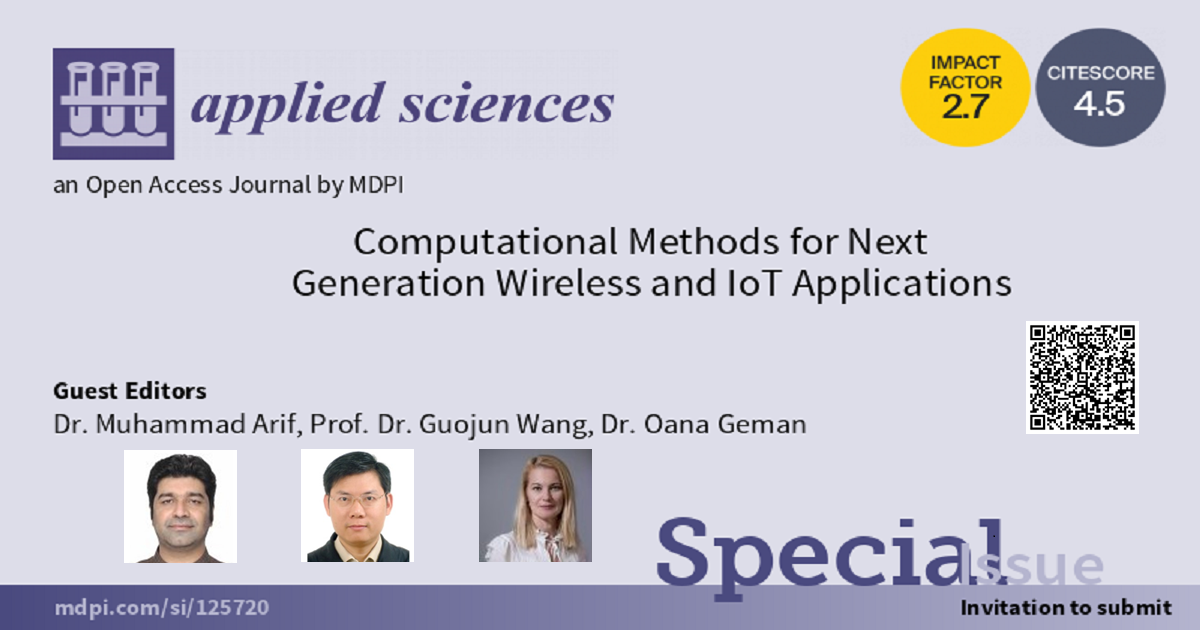Computational Methods for Next Generation Wireless and IoT Applications
A special issue of Applied Sciences (ISSN 2076-3417). This special issue belongs to the section "Computing and Artificial Intelligence".
Deadline for manuscript submissions: closed (31 July 2023) | Viewed by 28192

Special Issue Editors
Interests: artificial intelligence; big data; cloud computing; cyberspace security; data mining; image processing; medical image processing; privacy; security; e-learning
Special Issues, Collections and Topics in MDPI journals
Interests: system security; network security; trusted computing
Special Issues, Collections and Topics in MDPI journals
Interests: bio-engineering; bio-signal processing; healthcare informatics; deep learning; medical IoT
Special Issues, Collections and Topics in MDPI journals
Special Issue Information
Dear Colleagues,
Today, the increasing number of actuators, smart devices and sensors helped the Internet of Things (IoT) to improve the intelligence of the information and wireless communication technologies with a fast transition towards flexible, smarter, automated and reactive services. In order to respond to the needs more quickly or match the smart services with modified requirements, wireless communications have facilitated the interconnections of things between IoT applications, users and smart devices to take advantage of available services in the Internet. Wireless and IoT applications play a major role in IoT systems, since deploying several sensors through wired connection is tedious, and for some applications, it is impossible to establish wired communication.
Due to the advances in radio technologies and wireless application protocols, it is possible to employ wireless links for data communication in IoT systems and applications. In order to enhance the cover of IoT applications, many important issues need to be overcome in wireless and IoT applications. In addition, data mining techniques have been considered promising approaches to unleash the full potential of wireless communications. To overcome the aforementioned challenges of emerging wireless and IoT applications, this Special Issue invites researchers to publish selected original articles presenting intelligent trends to solve new challenges of new problems. We are also interested in review articles as the state-of-the-art of this topic, showing recent major advances and discoveries, significant gaps in the research and new future issues.
The basic aim of this Special Issue is to present state-of-the-art research contributions that address the next generations challenges and IoT applications in networks design. Designing, dimensioning and optimization of communication networks resources and services have been an inseparable part of the development of IoT, telecommunications and ICT infrastructures from the very beginning of their existence. Those networking problems have changed substantially over the recent years as a result of the changes in users’ requirements for the communications convergent multi-service wired and wireless networks.
Methodologies, and Techniques:
- Device to device communication strategies in the IoT applications
- 5G/6G wireless communications and IoT applications
- IoT services, protocols and architectures based on 5G wireless communications
- Cloud/Fog-based architectures in IoT applications, and Energy efficiency for IoT applications
- Embedded systems and RFID technology for IoT applications
- Big Data for wireless communications and IoT applications
- Formal verification and analysis on wireless communications for IoT applications
- Emerging and critical aspects for medical systems in IoT applications
- Smart city, smart home, smart agriculture and transportation management
- High performance image processing for IoT applications
- Industrial and manufacturing technologies for IoT applications
- Robotic and mechatronic issues in IoT applications
- Privacy and trust management of healthcare monitoring for IoT applications
- Vehicle-to-vehicle and mobility management for IoT applications
- Block-chain and Backdoor applications on IoT communications, Artificial Intelligence and Information Systems
Dr. Muhammad Arif
Prof. Dr. Guojun Wang
Dr. Oana Geman
Guest Editors
Manuscript Submission Information
Manuscripts should be submitted online at www.mdpi.com by registering and logging in to this website. Once you are registered, click here to go to the submission form. Manuscripts can be submitted until the deadline. All submissions that pass pre-check are peer-reviewed. Accepted papers will be published continuously in the journal (as soon as accepted) and will be listed together on the special issue website. Research articles, review articles as well as short communications are invited. For planned papers, a title and short abstract (about 100 words) can be sent to the Editorial Office for announcement on this website.
Submitted manuscripts should not have been published previously, nor be under consideration for publication elsewhere (except conference proceedings papers). All manuscripts are thoroughly refereed through a single-blind peer-review process. A guide for authors and other relevant information for submission of manuscripts is available on the Instructions for Authors page. Applied Sciences is an international peer-reviewed open access semimonthly journal published by MDPI.
Please visit the Instructions for Authors page before submitting a manuscript. The Article Processing Charge (APC) for publication in this open access journal is 2400 CHF (Swiss Francs). Submitted papers should be well formatted and use good English. Authors may use MDPI's English editing service prior to publication or during author revisions.
Benefits of Publishing in a Special Issue
- Ease of navigation: Grouping papers by topic helps scholars navigate broad scope journals more efficiently.
- Greater discoverability: Special Issues support the reach and impact of scientific research. Articles in Special Issues are more discoverable and cited more frequently.
- Expansion of research network: Special Issues facilitate connections among authors, fostering scientific collaborations.
- External promotion: Articles in Special Issues are often promoted through the journal's social media, increasing their visibility.
- e-Book format: Special Issues with more than 10 articles can be published as dedicated e-books, ensuring wide and rapid dissemination.
Further information on MDPI's Special Issue polices can be found here.







